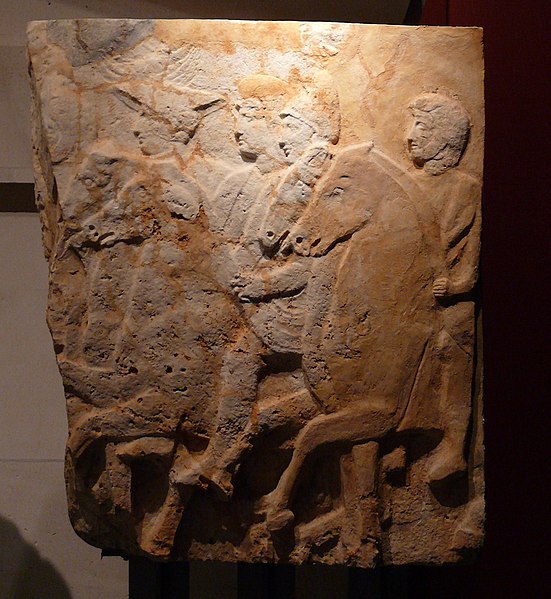The Lycian language was the language of the ancient Lycians who occupied the Anatolian region known during the Iron Age as Lycia. Most texts date back to the fifth and fourth century BC. Two languages are known as Lycian: regular Lycian or Lycian A, and Lycian B or Milyan.
Lycian became extinct around the beginning of the first century BC, replaced by the Ancient Greek language during the Hellenization of Anatolia. Lycian had its own alphabet, which was closely related to the Greek alphabet but included at least one character borrowed from Carian as well as characters proper to the language. The words were often separated by two points.
Xanthos stele with Lycian inscriptions
Payava (his name is Pamphylian) as depicted on his tomb. The Lycian inscription runs: “Payava, son of Ed[...], acquired [this grave] in the sacred [burial] area of the acropolis(?) of A[rttumba]ra (a Lycian ruler), when Lycia saw(?) S[alas](??) [as governor(?)]. This tomb I made, a 10 year [h]iti (project?), by means of Xanthian ahamas.” Payava may be the soldier at the right, honoring his ruler Arttumbara with a laurel wreath. 375-360 BC.
The inscription on the front of Payava's tomb in the Lycian language.
Lycian alphabet: an early attempt at transliteration
Lycians is the name of various peoples who lived, at different times, in Lycia, a geopolitical area in Anatolia.
A Lycian warrior, fresco from Kizilbel, Lycia, c. 525 BCE
The Lycian Payava as depicted on his tomb. The Lycian inscription runs: "Payava, son of Ad[...], secretary of A[...]rah, by race a Lycian ...". 375–360 BCE.
Lycian tomb relief at Myra, 4th century BCE.
Horsemen, on the tomb of Pericles, last Lycian ruler.


![Payava (his name is Pamphylian) as depicted on his tomb. The Lycian inscription runs: “Payava, son of Ed[...], acquired [this grave] in the sacred [bu](https://upload.wikimedia.org/wikipedia/commons/thumb/f/fb/Tomb_Payava_south_BM_950.jpg/640px-Tomb_Payava_south_BM_950.jpg)




